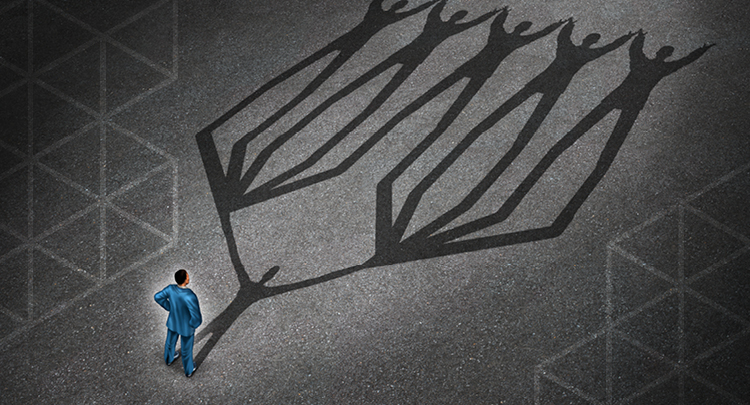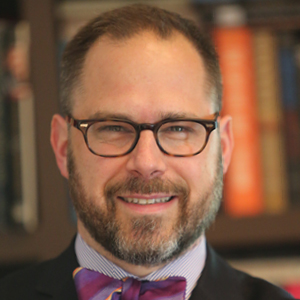Top-Down, Meet Bottom-Up: Elite Power, New Power, and Sharing Power


The simple answer is both — it often happens when there is collective leadership creating pressure on the outside of an institution, and allies inside the institution or with the power to influence the institution leveraging that pressure to create change. These two groups of leaders, however, are very different. As our social, political, economic, and media bubbles move further apart and become less porous, creating linkages among them has become more challenging. We must understand the dynamics that allow bottom-up and top-down to work together: the need for people to believe in their ability to lead and the need for leaders in positions of traditional power to share or give up power. Two new books offer important insights on how power has often operated and how it might operate more inclusively.
First, we must understand and encourage bottom-up leadership. Six years ago, I wrote Everyone Leads: Building Leadership from the Community Up to share my lessons from twenty years developing more than 5,000 diverse young leaders across the United States through Public Allies. We saw a teen mother in community college eventually become a White House lawyer, a deli worker become a top disability rights advocate, a shoe salesman become a top public health leader at a major hospital.
We learned through hundreds of stories like these that leadership is a muscle everyone has, and that like any other muscle it can be developed with practice and exercise. If we focus on the verb — to lead — rather than the noun — leader — and understand it as an act of taking responsibility to achieve a result with others, we can think differently about who can lead. The goal of any organization or community ought to be to build that collective leadership muscle, to create opportunities for many people to step up and lead.
“[L]eadership is a muscle everyone has, and that like any other muscle it can be developed with practice and exercise.”
Throughout history, leadership has often come from the leadership of the many, from ordinary people doing extraordinary things together. I often tell the story of the Montgomery Bus Boycott, and how a seamstress, her husband the barber, the train porter, the cook, the bar owner, the English professor, the teenage activists, the lawyer, and a 26-year-old pastor came together to make history.
Looking back further, America wasn’t created by a founding father, but by founding fathers. And a true reading of history finds many founding mothers, and additional founding fathers among the farmers, blacksmiths, and free African American men who self organized to challenge the most powerful army in the world at Lexington and Concord. Despite pervasive heroic leadership narratives in our culture, history is filled with such stories of diverse and collective leadership.
But leadership that has emerged from more grassroots origins has often encountered the same roadblock: the resistance of individuals with economic, political, or institutional power. These individuals often believe in heroic leadership models, and see extraordinary leadership potential primarily in people who look like them and come from the same background. At Public Allies, I found myself more than once arguing with philanthropists who believed that people like their children were better suited to make a difference in low-income communities of color than young people from those communities. I also experienced the arrogance of philanthropists who believed that because they wrote a compelling software code or invested wealth wisely that they knew better how to solve public problems like education and poverty than people with actual expertise. In my consulting work, I have witnessed powerful allies grab back control when grassroots leaders or coalitions began attracting attention and resources. Empowerment is often more talk than action.
Anan Giridharadas’s new book, Winners Take All: The Elite Charade of Changing the World, is a thoughtful and provocative rebuke of such elite power and how it undermines good intentions. Giridharadas’s criticism is aimed at “MarketWorld,” the rarefied space where elite business leaders and philanthropists engage with government officials, thought leaders, and prominent nonprofit leaders to seek win-win solutions to public problems like education, climate change, and poverty. The problem is that to ensure there is a win-win, no criticism of business leaders’ practices or philanthropists’ investments that contribute to problems can be discussed. No sacrifice can be asked of them. For example, we can talk about educational opportunity as a means of overcoming poverty, but not living wages, affordable housing, and accessible health care. And we especially cannot speak of business leaders’ or philanthropists’ complicity through their business practices or their advocacy for public policies that contribute to the problems they want to solve. We can only talk about what they give, never what they take or have taken.
Power in MarketWorld grows by never rocking boats. Thought leaders must curtail their criticisms, nonprofit leaders must never discuss root causes. Everyone, even government officials, must agree that government doesn’t work and the private sector works better. The “do well by doing good” ethos that pervades MarketWorld has attracted a new generation of privileged people to the public square, overconfident that their market mindsets, ability to inspire elite leaders (who come from the same background), and MarketWorld tool box (management consulting formulas, business school jargon, spreadsheets, and PowerPoints) entitle them to lead in communities they have not lived in on issues they have not experienced or worked on before.
The MarketWorld ethos has dominated social change conversations at places like Davos, Aspen, and the Clinton Global Initiative. It has also increasingly infiltrated conversations in communities where young entrepreneurs, wealthy heirs, and those with prestigious résumés are more likely to get celebrated and rewarded for their social innovations than those with deep experience working and innovating on community problems (and who care less about doing well than doing good).
Previous books such as Thomas Frank’s Listen Liberal: Or, What Ever Happened to the Party of the People?, Richard Reeves’ Dream Hoarders: How the American Upper Middle Class is Leaving Everyone Else in the Dust, Why That Is a Problem, and What to Do About It, and David Callahan’s The Givers: Wealth, Power, and Philanthropy in a New Gilded Age have covered similar ground, but none with the vigor, honesty, and even empathy of Giridharadas. Of course, we want people with wealth and power to participate in the public square and to contribute their experience, expertise, and wealth to public problem solving. But we need them to do it with authenticity, humility, and a willingness to build, share, and give up power.
New Power: How Power Works in Our Hyperconnected World — and How to Make it Work for You by Jeremy Heimans and Henry Timms is a compelling and timely exploration of new platforms that move away from elite power to more generative and shared power. Through a wide range of examples that include the Ice Bucket Challenge, #BlackLivesMatter, Etsy, Invisible Children’s Kony 2012, AirBnB, the NRA, and ISIS, they demonstrate how leaders and groups have harnessed and leveraged new technological platforms and cultural changes to catalyze individuals to step up and act individually and together as a powerful force for innovation and change. They outline the shifts from old power values to new power values as moving from formal to informal, competition to collaboration, confidentiality to transparency, expertise to “do it yourself,” exclusive loyalty to conditional loyalty. New power leaders have learned that platforms spread ideas when they are actionable — people have a pathway to take action; connected — they give people a sense of belonging and ways to work together; and extensible — they enable people to customize, remix, and make them their own.
“Like every other system in our society, new power will not be more equitable unless it equity is intentionally built into the leaders’ ethos, structures, and practices.”
They have created a new textbook for 21st Century social change, and the stories of viral campaigns, empowering platforms, movements, and even cautionary tales are both inspiring and instructive. Generative and collective leadership have always been at the center of social change, but new power platforms make it easier to build leader-full organizations, coalitions, and campaigns today. Not surprisingly, the authors find the most effective efforts often link some combination of old power (top-down) and new power (bottom-up). The challenge with their analysis is that the platforms and tools of new power are often more accessible to those with traditional power, privilege, and resources. Like every other system in our society, new power will not be more equitable unless it equity is intentionally built into the leaders’ ethos, structures, and practices.
While I believe New Power is a worthy antidote to Giridharadas’s MarketWorld, I think there are at least three additional mindset shifts that are helpful for leaders with power and privilege to engage collective leadership to move social change:
Social change in communities or on larger social issues will only happen when we create platforms that encourage, engage, and empower the leadership of the many, and when leaders who hold traditional power collaborate inclusively and effectively with those populations. Elite power needs to explicitly and transparently commit to work differently if they want to achieve their intended social changes and impacts. The practices of new power, when combined with explicit efforts to share power, demand equity, and practice humility can make it possible for diverse coalitions to build collective power and leadership to achieve social impact and social change together.
